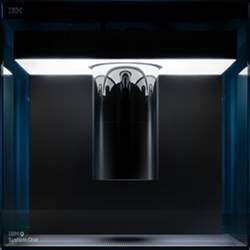
The Consumer Electronics Show 2019 in Las Vegas will be remembered as the venue where the world's first commercially available universal quantum computer debuted. The superconducting behemoth is isolated inside a nine-foot air-tight cube of half-inch-thick borosilicate glass. Unlike D-Wave's 2000Q quantum computer, which can only solve optimization problems, IBM's Q System One can take on any quantum problem—from uncrackable cryptography to NP-Hard (non-deterministic polynomial-time hard) problems.
IBM Q chief technology officer Bob Wisnieff said the new system "is the world's first universal quantum system to expand quantum computing beyond the research lab for commercial quantum applications in business and science."
A major drawback, however, is that the algorithm used must execute in under 100 microseconds—the quantum decoherence time of the 20 quantum bits (qubits) on an IBM Q System One. The magic of qubits—the superposition of both 1s and 0s—enables them to solve the toughest NP-Hard problems. Unfortunately, even with a record-breaking 100 microseconds before qubit decoherence, the most famous quantum algorithms (Shor's algorithm for factoring, and Grover's algorithm for searching) take too long to solve.
So far.
The next step in universal quantum computing will be fault-tolerant enhancements that extend decoherence indefinitely with error-correction mechanisms that sidestep decoherence by passing quantum states along from gate to gate. Each gate will perform its work, pass its results through the error-correction mechanism, and then transfer the restored qubit along to the next quantum gate. In this way, quantum computers will be able to handle Shor's algorithm (for finding the keys for even the longest encryption codes) and Grover's algorithm (for searching even the largest unstructured databases), someday. In the mean time, one of the biggest uses of IBM's Q System One will be to design and perfect these error-correction algorithms.
"There is a big misnomer that people should avoid regarding IBM's announcement," said Brian Hopkins, vice president and principal analyst at market research firm Forrester Research. "What IBM is announcing is the first universal quantum computer that isn't just a chip, but is a complete system that can be upgraded one module at a time, as more qubit processors, better cryogenic coolers, better firmware and software become available."
For now, users of IBM's Q System One will gets a fourth-generation 20-qubit quantum processor—with 50-qubit upgrades anticipated by 2020—that can execute quantum algorithms in 100 microsecond "batches" to achieve what the company calls "approximate" solutions. The utility of the Q System One for specific applications, according to Hopkins, will depend on how clever the user is at writing quantum algorithms.
IBM will allow potential buyers to try out their quantum algorithms using remote access portals to the new IBM Q Quantum Computation Center in Poughkeepsie, NY.
The computer maker claims its future fault-tolerant upgrades will help businesses in all sorts of ways, including better financial modeling and better investment choices. IBM also is confident that universal gate-level algorithms will allow future models to tackle the same problems D-Wave's quantum computers can handle today, such as optimizing delivery routes, logistics support, and assessing global risk factors.
On the other hand, D-Wave also is confident its optimization-only quantum computer will be able to solve the same NP-Hard problems as IBM's quantum computer—that is, once the quantum error-correction problem has been solved.
However, "It's not clear today that quantum error-correction will ever be achieved," said Hopkins. "So I prefer to call it the error-mitigation problem, since the quantum algorithms will likely incrementally get better and better, even if they never completely eliminate quantum errors."
Today, the modular Q System One stabilizes its auto-calibrated qubit processing capabilities in order to provide repeatable, predictable operations that can be used in tandem with traditional computers for hybrid algorithm execution. Its integral cryogenic supercooled environment is also capable of isolating and tightly controlling larger numbers of qubits for future upgrades in more fault-tolerant configurations. Also, IBM includes quantum firmware that insures the constant health of its Q System One, and also provides the ability to perform system upgrades without extensive downtime.
Existing members of the IBM Q Network (which receive support, training, and enablement from IBM technical experts) will receive access to the new IBM Q Quantum Computation Center. Members of the network range from startups to academic institutions, national research labs, and Fortune 500 companies, such as Barclays, Honda, Hitachi Metals, ExxonMobil, Argonne National Laboratory, the European Organization for Nuclear Research (CERN), Fermilab, Lawrence Berkeley National Laboratory, Cambridge Quantum Computing, Nagase, Strange Works, Q-Cntl, QCware, Quantum Benchmarks, Q-Branch, Zapata, and 1Qbit.
The superconducting qubits and cryogenic cooler of the Q System One are sealed in a nine-foot glass cube using motor-driven rotation translation around two axes in order to accommodate quick upgrades and maintenance. Inside the cube, separate aluminum and steel frames decouple the cryostat, conventional electronics and superconducting gates to mitigate potential phase jitter and premature qubit decoherence.
The IBM Q Experience will remain online and free to the public; more than 100,000 users have tested the system so far by running over 6.7 million quantum jobs.
R. Colin Johnson is a Kyoto Prize Fellow who has worked as a technology journalist for two decades.



Join the Discussion (0)
Become a Member or Sign In to Post a Comment